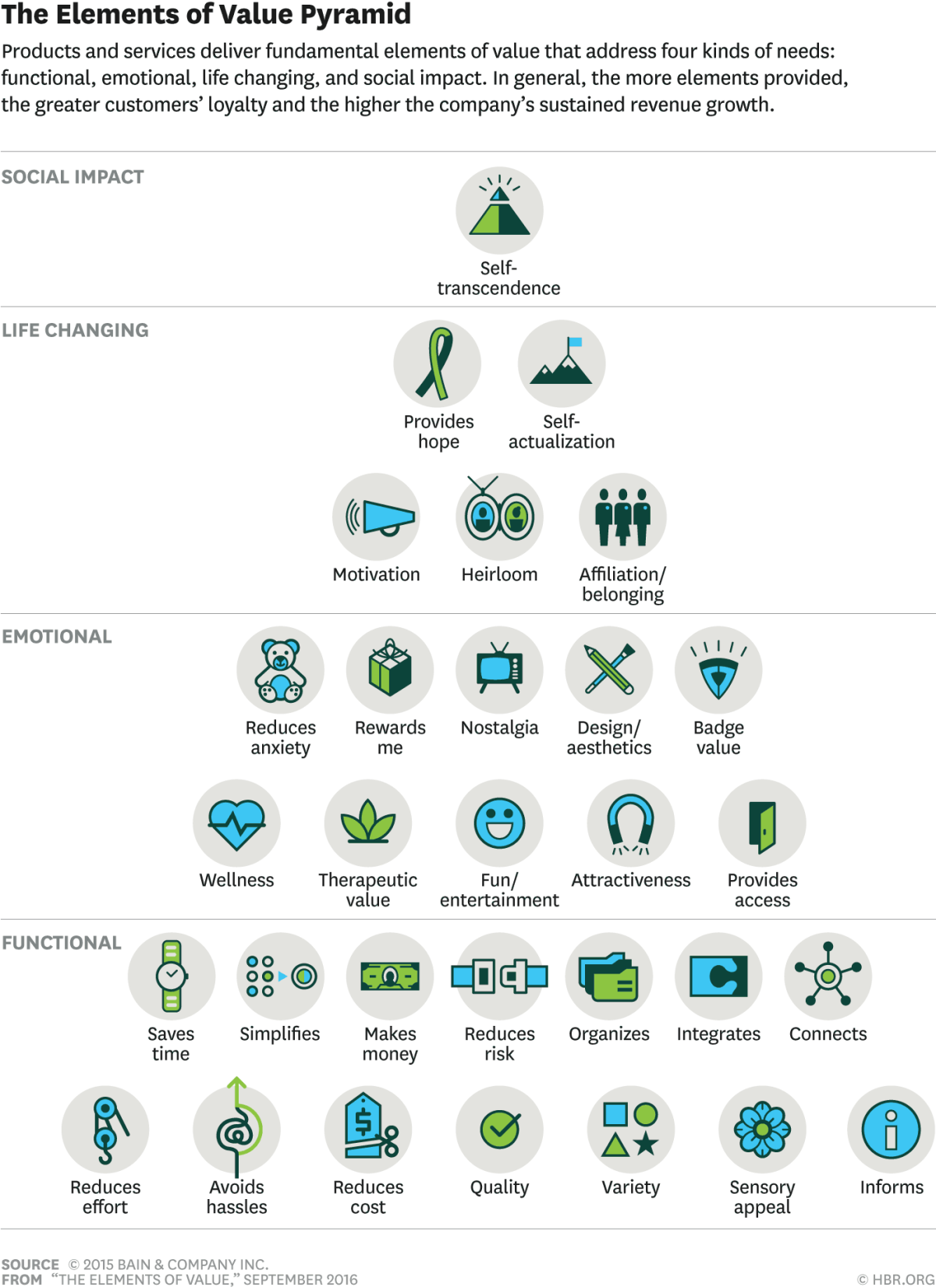
In a recent article by The Harvard Business Review, two researchers aimed to identify a complete list of customer values.
They looked closely at the value propositions that can be added to a product, brand, or service to make customers feel more satisfied and happy with their purchase. The researchers created a list of values that “companies can select and integrate innovations into their products to provide value that consumers actually want.”
The Four Categories of Customer Values
In the article “The 30 Things That Customers Really Value,” Eric Almquist and his colleagues classified customer values into four categories.
- Functional — the qualities of the brand, product, or service
- Emotional — the way the brand, product, or service makes the customer feel
- Life-Changing — the way the brand, product, or service alters the life of the customer
- Social Impact — the way the brand, product, or service alters the life of others
The researchers believe that individual sources of value in these categories can be added to products and services to make them more desirable for customers.
Small changes could also increase customer perception about brands as a whole. Incorporating values from the list into a brand promise or unique selling proposition could differentiate businesses and develop a deeper brand affinity, recognition, and loyalty.
The researchers broke down the categories into individual values propositions that could be added to products, services, and brand values.
SOCIAL IMPACT:
- Self-transcendence
LIFE-CHANGING:
- Provides hope
- Self-actualization
- Motivation
- Heirloom
- Affiliation/Belonging
EMOTIONAL:
- Reduces anxiety
- Rewards me
- Nostalgia
- Design/Aesthetics
- Badge value
- Wellness
- Therapeutic value
- Fun/Entertainment
- Attractiveness
- Provides access
FUNCTIONAL:
- Saves time
- Simplifies
- Makes money
- Reduces risk
- Organizes
- Integrates
- Connects
- Reduces effort
- Avoids hassles
- Reduces cost
- Quality
- Variety
- Sensory appeal
- Informs

Click here to read the full article by the Harvard Business Review.
So, What Does This Mean For Businesses and Brands?
As a retailer, business owner, or brand, you can take elements of this list and incorporate them into your offerings to better appeal to and please customers. By adding value upgrades, you can develop products and services that will increase customer satisfaction and loyalty.
Let’s look at a few examples.
Examples of Customer Values In a Retail Store. A small children’s boutique that sells high-end baby clothes and toys may choose to incorporate: heirloom, fun/entertainment, and avoids hassle. The boutique could:
- Create signature offerings and events that allow parents to create custom keepsakes (heirloom).
- Build a designated area in the store where children can play while their parents shop (fun/entertainment).
- Develop an online profile for children so that family and friends can check to see what size the child is when buying gifts and clothing (avoids hassle).
Examples of Customer Values In an Auto Shop. An auto shop that offers state inspections, oil changes, and tune-ups may use: organizes, reward me, and informs. The auto shop could:
- Create auto profiles so customers can track their services and receive notifications when services are due (organizes).
- Implement loyalty programs that reward customers for their continued patronage (reward me).
- Provide in-store educational digital signage content that describes products and services in a way that customers who are unfamiliar with the auto industry can understand (informs).
Examples of Customer Values At a Healthcare Practice. These values can also be incorporated into healthcare practices. A downtown dentist’s office that caters to busy professionals may focus on the values: reduces effort, design/aesthetic, and wellness. The dentist office could:
- Provide online booking and calling services to remind patients about their upcoming appointments (reduces effort).
- Improve their waiting room and create a beautiful, high-end space that feels more like a spa than a dentist’s office (design/aesthetic).
- Form partnerships with other healthcare and wellness facilities to offer discounts and promote overall well-being (wellness).
Examples of Customer Values At a Hotel. Values are also relevant to businesses in the hospitality industry. A small boutique hotel along the beach in Florida may choose to incorporate: therapeutic, affiliation/belonging, and sensory appeal. The hotel could:
- Provide additional services such as massage, therapeutic yoga, spas, and meditation (therapeutic).
- Create a community by setting up an online group or in-person, annual event that is focused on the other values their property supports (affiliation/belonging).
- Offer themed hotel rooms that make guests feel as though they are in another time and place (sensory appeal).
How To Determine Where You Can Add Customer Values
As you try to determine what values you can add to your business, products, or services, consider the following.
What values does your business already promote? Without consciously planning, it is likely that your business already has value propositions on this list. Outline those values and consider how other supporting values can blend with your current model.
What values are specifically important to customers in your industry? The Harvard Business Review researchers found that certain values mattered more to customers depending on the industry. Consider your industry and look at what is most important to your customers. Then, make sure you meet those standards.
What are values that your competitors have incorporated into their business? Look for ways to differentiate your business from theirs. If they put an emphasis on variety, you may want to focus on something different like quality, which will allow you to capture customers who value quality over variety.
What values are missing from your industry? As you look at your industry as a whole, look at how you can incorporate some extra, non-traditional values that will help you stand out in your field.
What values does your target customer care about most? Customer ideals and beliefs should also drive your decision making when it comes to selecting value propositions to add to your business, products, and services. Be sure to clearly define your target audience and familiarize yourself with their wants, needs, and worldviews so you can match your values with theirs.
Hopefully, this post sparked some ideas for how you can adjust your products, services, offerings, and brand propositions to connect with important customer values.
If you’re looking for even more ways to wow customers by providing memorable and special experiences, check out our free ebook How to Provide Exceptional Customer Experiences Through Audio and Video.
The guide offers actionable tips and tactics you can use to elevate your in-store atmosphere to wow and impress customers and guests.